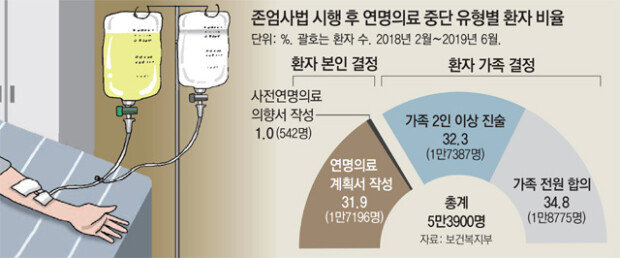54,000 Koreans choose death with dignity
54,000 Koreans choose death with dignity
Posted July. 12, 2019 07:31,
Updated July. 12, 2019 07:31

At 3 p.m. on Thursday, a 78-year-old Korean surnamed Ryu living in Eunpyeong-gu, Seoul walked into a counseling center in Seongbuk-gu, Seoul, which helps its visitors make decisions on life-sustaining treatment. He isn’t ill yet but he wanted to fill out a form to express his decision on life-sustaining treatment in advance.
There are now increasingly more people who are currently healthy like Ryu yet willing to sign the form, advance statement on life-sustaining treatment, to make a decision on life-sustaining treatment ahead of time. The term “life-sustaining treatment” means medical treatment by cardiopulmonary resuscitation, mechanical ventilation, hemodialysis, administering anticancer drugs, and extracorporeal life support to a patient at the end of life, which merely extend the duration of the end-of-life process without curative effect. As the Act on Hospice and Palliative Care and Decisions on Life-Sustaining Treatment for Patients at the End of Life came into force in February last year, patients and their families are now able to make a decision to suspend life-sustaining treatment.
As of June 30, 2019 – 17 months into the enforcement of the so-called “death with dignity” act – 256,025 people submitted the form indicating their decisions on life-sustaining treatment, according to the South Korean Ministry of Health and Welfare on Thursday. This figure is more than double the number of such people on January 3, about half a year ago, standing at 101,773.
Over 50,000 patients chose to die with dignity during the same period as well. According to the health ministry, a total of 53,900 patients – 32,460 males and 21,440 females – decided that their life-sustaining treatment had to be either “withheld,” meaning no treatment was to be provided from the beginning, or “suspended,” meaning their initial treatment was discontinued. Among them, 31.9 percent of these patients – 17,738 people – expressed their intention for the suspension of such treatment. Another 31.9 percent – 17,7196 patients – were the cases that terminal or critically ill patients made such decision after consultation with doctors. Those who submitted an advance statement on life-sustaining treatment accounted for one percent – 542 patients.
“The death with dignity act is a way to help people reflect on their past life and prepare themselves for death,” said Hong Yang-hee, the head of the advance statement on life-sustaining treatment promotion council. “Although more and more people writing an advance statement on life-sustaining treatment, we need a lot more promotion of the system as there are far too many who aren’t aware of this yet.”
wizi@donga.com







